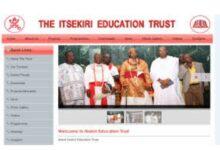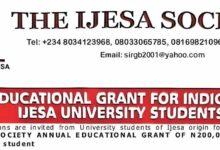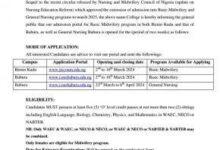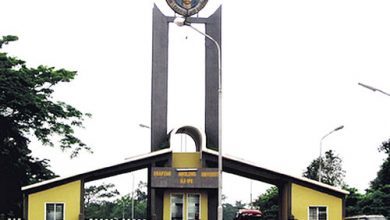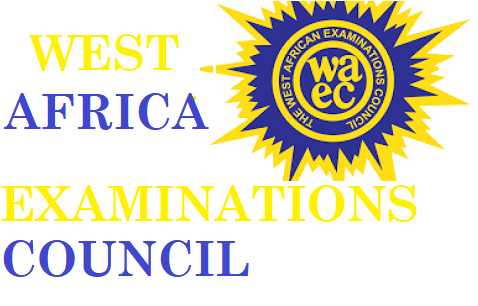
WAEC Syllabus for Geography
WAEC Syllabus for Geography. WAEC Syllabus for Geography is available for all candidates who want to participate in the examination. The West African examination council (WAEC) has officially introduced a syllabus that will guide all the WAEC candidates who wish to write the WAEC examination this year. For a very successful WAEC Geography examination for this year, you need to check out the available areas of concentration. It has been divided into sections with chapters, followed by the topics to be covered in preparation for the exams. In the WAEC Syllabus for Geography, you will also see the format of how the WAEC Geography questions will be presented.

👉 Relocate to Canada Today!
Live, Study and Work in Canada. No Payment is Required! Hurry Now click here to Apply >> Immigrate to CanadaThere are 3 sections to answer questions from. Paper 1 is Objective and paper 2 contains essay questions and paper 3 is the practical section. Where paper one (1) carries 1 hour for 50 marks; paper two (2) carries 2 hours for 80 marks and paper 3 1 hour 50 minutes for 70 marks.
This WAEC syllabus is for both the O’level WAEC and General Certificate Examination (GCE) candidates. Final year students in the senior secondary school level and external candidates are eligible to make use of this syllabus and prepare ahead of the examination. WAEC Syllabus for Geography
See the full detailed information concerning the WAEC Geography Syllabus below.
PREAMBLE
The Geography syllabus is designed to evaluate candidates’ knowledge of the features of the earth’s crust (internal and external), the spatial spread of the physical and human features, the interactions that exist between man and these spatial features, the changes that occur over space as well as the effects of those changes on man with a view to maintaining sustainability in man’s ecosystem. This examination syllabus is based on the assumption that not less than three hours of teaching per week will be allocated to the subject.
AIMS AND OBJECTIVES
The examination will test the candidates’ ability to
- explain the concepts of differential character and the spatial relationships of the surface features of the earth;
- explain the concepts of man- environment relations (i.e. to analyse the life of man within his physical and cultural environments and to explain their interactions);
- demonstrate a basic knowledge of the nature and functioning of physical and human environments, particularly an understanding of their inter-relationships and the resulting issues;
- organize and formulate principles according to acquired geographical concepts and then apply these principles to interpret and analyze spatial problems in the immediate and wider environments;
- demonstrate skills and techniques for accurate, orderly and objective geographical investigations to be carried out both in the classrooms and in the immediate environment;
- communicate geographical ideas effectively through reports, graphs, charts, sketches, diagrams and maps;
- explain the cultural, social and economic circumstances of people in their immediate environments and those of other countries within the sub-region. Naira to Pounds
SCHEME OF EXAMINATION
There will be three papers, Papers 1, 2 and 3 all of which must be taken. Papers 1 and 2 will be a composite paper to be taken at one sitting.
PAPER 1: will consist of fifty objective questions to be taken in 1 hour for 50 marks. The questions will be drawn from topics in the syllabus that are common to all the member countries. Candidates will be required to attempt all the questions.
PAPER 2: will contain nine essay-type questions out of which candidates will be required to answer four in 2 hours for 80 marks.
👉 Relocate to Canada Today!
Live, Study and Work in Canada. No Payment is Required! Hurry Now click here to Apply >> Immigrate to CanadaIt will be made up of two sections; Sections A and B for candidates in Nigeria and three sections; Sections A, B and C for candidates in Ghana, Liberia, Sierra Leone and The Gambia.
Candidates in Nigeria will be required to attempt four questions in all, choosing two questions from each of Sections A and B. Candidates in Ghana, Liberia, Sierra Leone and The Gambia will be required to attempt four questions in all, choosing at least one question from each of Sections A, B and C. Jamb Result
The questions will be distributed in the sections as follows:
Section A: Economic and Human Geography
This will consist of three essay-type questions on Economic and Human Geography. Candidates in Nigeria will be required to attempt any two of them while candidates in Ghana, Liberia, Sierra Leone and The Gambia are to attempt at least one of the questions.
Section B: Regional Geography of Candidate’s Home Country
There will be a set of three essay-type questions on Regional Geography on each of Ghana, Liberia, Nigeria, Sierra Leone and The Gambia. Candidates in Nigeria will be required to answer two of the questions on their country while those in the other countries will answer at least one out of the sets for their countries.
Section C: Regional Geography of Africa
There will be three essay-type questions drawn from Africa for candidates in Ghana, Sierra Leone, Liberia and The Gambia out of which candidates are expected to answer at least one. Dollar to Naira Rate
PAPER 3: Element of Practical and Physical Geography
Will consist of eight essay-type questions out of which candidates are to answer four in 1 hour 50 minutes for 70 marks. Question 1, on map reading and interpretation, will be compulsory for all candidates and will carry 25 marks while the other questions will carry 15 marks each. Candidates are advised not to spend more than 35 minutes on Question 1. Candidates will be expected to bring graduated rulers (both metric and imperial), a complete mathematical set, a piece of string and a simple non-programmable calculator for use during the writing of the paper.
DETAILED SYLLABUS
Any topic in the syllabus that is marked with one asterisk (*) will be for candidates in Ghana, Sierra Leone, Liberia and The Gambia. Topics that are marked with two asterisks (**) will be for candidates in Nigeria only. The topics without an asterisk are for all member countries.
| CONTENTS | NOTES |
| ELEMENTS OF
PRACTICAL AND PHYSICAL GEOGRAPHY Map work
*Principles of elementary surveying
**Geographic Information System (GIS)
Statistical maps and diagrams
Elements of Physical Geography
*Hydrosphere
(i) Rocks
(ii) Tectonic processes
(iii) Denudational processes
(iv) Weather and climate
(v) Climate (a) Elements
(b) Classification
** (c ) Climate change
*(vi) Vegetation
*(vii)Soil
(vii)The environment
(a) Environmental resources
(b) Environmental problems/ hazards
(c) Environmental conservation |
Maps: meaning, types and uses. Map reading and interpretation based on contoured survey maps of parts of West Africa: scale, measurement of distances, direction and bearing, map reduction and enlargement, identification of physical features such as spurs, valleys, etc. and cultural features such as city walls, settlements, communication routes, etc.; measurement of gradients, drawing of cross profiles, inter-visibility, description and explanation of drainage characteristics and pattern; patterns of communication, settlement and land use.
Definitions of terms, instruments, chain and prismatic compass, plotting of traverse, avoiding obstacles in the field.
GIS: Basic concepts, components (hardware, software, data, procedures and experts); sources of data (land surveying, remote sensing, map digitizing, map scanning, field investigation and tabular data etc); uses (defence, agriculture, urban development, mapping, surveying, transportation, census etc), problems (power, personnel, capital etc).
Graphical representation of statistical data: Bar graphs, Line graphs, flow charts, dot maps, proportional circles, density maps, isopleth maps.
The earth as a planet in relation to the sun, latitude and distance, longitude and time, earth’s rotation and revolution and their effects, structure of the earth (internal and external).
Ocean basins, salinity, ocean current ( causes, types and their effects on the temperature of adjacent coastlands), lakes, rivers, lagoons, water as an environmental resource.
Types, characteristics, formation and uses.
Vulcanicity, earthquake, landforms: Mountains, plains, karsts and coastal landforms (formation, characteristics and importance).
Agencies modifying landforms such as weathering, mass movement, running water, underground water, wind and waves.
Simple weather study based on local observation, description of the Stevenson’s screen and uses of basic weather instruments e.g. rain gauge, thermometer, barometer, wind vane etc.
Rainfall, sunshine, air pressure, wind, humidity, temperature and cloud. Factors affecting climatic elements e.g. altitude, latitude, ocean currents, land and sea breezes, continentality, aspect. Interpretation of climatic charts and data.
Major types of climate (Hot climate – Equatorial, Tropical Continental, Desert; Temperate climate – warm and cool). Classification of climate based on Greek and Koppen. Meaning, causes, effects and remedies.
Major types (Tropical Rainforest, cool/warm temperate woodland, Tropical Grassland); characteristics, distribution, factors affecting their distribution, plant communities. Vegetation as an environmental resource. Conservation of vegetation resources.
Definition, local types and characteristics. Factors and processes of soil formation, soil profile, importance to man and the effects of human activities on soil. Soil erosion and conservation.
Meaning, classification ( renewable and non-renewable) types ( vegetation, water, mineral, atmospheric, etc ) and the importance of each.
Types (soil erosion, drought, desert encroachment, flooding and pollution), causes, effects and prevention of each.
Meaning, importance, methods, problems and solutions. |
| CONTENTS | NOTES |
|
ECONOMIC AND HUMAN GEOGRAPHY
(i) World Population (ii) Settlement (iii) Transportation Npower Recruitment (iv) Industry (v) Trade (vi) Tourism
|
Factors and patterns of growth, distribution and movement, growth rate problems.
Types (rural and urban); patterns and factors affecting location; growth and size; functions of rural and urban settlements; interaction patterns( urban-rural, rural-urban, urban-urban, rural-rural); migration.
Modes (roads, railways, water, air, pipeline, cables, ropeways etc.) Transportation and economic development (movement of people and commodities, national and international trade, diffusion of ideas and technology, national integration); problems of transportation and their solutions. Classification (primary, secondary and tertiary); types (heavy and light industry); factors of industrial location; contributions to development; problems/solutions. Meaning, types (national and international), reasons for trade, importance. Meaning, centres, reasons (leisure, recreation, education etc ); importance, problems and solutions. |
ASPECTS OF REGIONAL GEOGRAPHY PECULIAR TO MEMBER COUNTRIES
| CONTENTS | NOTES |
|
REGIONAL GEOGRAPHY OF NIGERIA
(a) Nigeria on broad outline
(b) Physical setting
(c) Population
(d) Resources
(e) Agriculture
(f) Transportation
(g) Communication
(h) Industry Waec Result (i) Trade
(j) Tourism
(k) Issues on development and environmental concerns
(l) ECOWAS
(m) Geo-political issues
REGIONAL GEOGRAPHY OF GHANA
(a) Ghana on broad outline
(b) Physical setting
(c) Population
(d) Settlement
(e) Primary economic activities
(i) Agriculture
(ii) Fishing
(iii) Lumbering
(iv) Mining
(f) Manufacturing
(g) Trade and commerce
(h) Tourism
(i) Energy and power
(i) Issues on development and environmental concerns
|
Location, position, size, distance and political divisions.
Relief, drainage, climate, vegetation
Size, distribution, structure, population quality, population movement, population data ( sources and problems/solutions)
Mineral (petroleum, gas, coal, tin/columbite, iron ore, limestone)- distribution, methods of extraction, problems and solutions)
Power (Petroleum, gas, coal HEP, solar energy)
Water (rivers, lakes, dams, sea, underground water)
Vegetation (trees, food and cash crops; timber,etc)- forest, savanna, biosphere.
Types of agricultural practices, food and cash crops, importance, problems and solutions.
Mode, advantages and disadvantages, problems and solutions, influence of transportation on human activities.
Communication networks, advantages and disadvantages, importance, problems and solutions.
Definition, types, major industrial zones, factors of location, importance, problems and solutions.
Meaning, types (national and international), stock exchange, capital market, forex, major commercial areas, importance of commercial activities.
Meaning, centres, reasons for tourism, importance, problems and solutions.
Issues of Development and Environmental Conservation: Rural and regional development, resource management and conservation, environmental pollution e.g. air, water, soil, noise; waste disposal, etc.
Meaning, member countries, purposes/mandate, advantages/benefits, disadvantages, problems and solutions.
Geo-political issues-Land reclamation.
Location, position, size, distance and political divisions.
Physical environment (geology, relief, drainage, climate, vegetation and soils).
Size, growth, distribution and density, age/sex structure: fertility, morbidity and mortality, migration.
Origin, types (rural and urban), characteristics, hierarchy, land use, urbanization processes, problems and solutions.
Subsistence (intensive and extensive) commercial (vegetable, livestock, dairying, commercial grain), plantation, problems and solutions.
Inland and ocean (in-shore/off shore), methods, types of fish, storage and marketing, importance, problems and solutions.
Sources of timber, methods of exploitation, types of species (for internal use and for export), problems and solutions, conservation.
Types, distribution of minerals, methods of extraction, importance, problems and solutions.
Types of manufacturing industries, distribution, factors influencing location of industries, problems of industrialization.
Services, transport and communication, recreation and tourism, administration.
Meaning, centres, reasons for tourism, importance, problems and solutions.
Water (Akosombo and Kpong Hydro-electric Power projects – benefits and side effects), fuel wood and charcoal, petroleum and natural gas (Saltpond), solar, wave and wind energies (Donkokrom and Kokrobite), Biogas e.g. cow dung.
Issues of Development and Environmental Conservation: Rural and regional development, resource management and conservation, environmental pollution e.g. air, water, soil, noise; waste disposal etc.
|
|
REGIONAL GEOGRAPHY OF SIERRA LEONE
(a) Sierra Leone on broad outline
(b) Primary economic activities
(i)Agriculture
(ii) Fishing
(iii) Lumbering
(iv) Mining
(c) Manufacturing
(d) Transport and communication
(e ) Trade
(f) Population
(g) Tourism
REGIONAL GEOGRAPHY OF LIBERIA
(a) Liberia on broad outline
(b) Physical setting
(c) Population
(d) Resources
(e) Agriculture
(f) Transportation
(g) Communication
(h) Industry
(i) Trade
(j) Tourism
(k) Fishing
(l) Mining
REGIONAL GEOGRAPHY OF SENEGAMBIA
(a) Senegambia on broad outline
(b) Physical setting
(c) Population
(d) Resources
(e) Agriculture
(f) Transportation
(g) Communication
(h) Industry
(i) Mining
(j) Fishing
(k) Issues on development and environmental concerns
(l) Trade
(m) Tourism
REGIONAL GEOGRAPHY OF AFRICA
(a) Africa on broad outline
(b) Selected topics (i) Irrigation agriculture
(ii) Plantation agriculture
(iii) Oil production
(iv) Lumbering
(v) Gold Mining
(vi) Copper mining
(vii) Population
(viii) ECOWAS
FIELD WORK
|
Size and location, physical environment, people and settlements.
Meaning of agriculture, Subsistence (intensive and extensive) commercial (vegetable, livestock, dairying, commercial grain production), plantation, problems and solutions.
Meaning of fishing, Inland and ocean (in-shore/off shore), methods, types of fish, storage and marketing, importance, problems and solutions.
Meaning of lumbering, Sources of timber, methods of exploitation, types of species (for internal use and for export), problems and solutions, conservation.
Types, distribution of minerals, methods of extraction, problems and solutions.
Location of industry, types of industries, problems of manufacturing industry, Energy and Power, water, fuelwood and charcoal, biogas (e.g. cow-dung), hydro-electric power projects e.g. Dodo, Guma, Bumbuna.
Road, rail, water, air, the roles of transport and communication to economic development,( internal and external trade, diffusion of ideas and technology), problems of transport and communication, solutions.
Major commodities of trade (agricultural, manufactured goods, minerals, etc.), patterns of trade (internal and external), problems of trade.
Size, growth, distribution and migration.
Meaning, development of tourism, problems of tourism & solutions, socio-economic effects of tourism. Main tourism areas, factors responsible for its development, economic importance.
Location, position, size, distance and political divisions.
Relief, drainage, climate, vegetation and soil.
Size, distribution, structure, population quality, population movement, population data ( sources, problems & solutions)
Mineral, power, water and vegetation resources, importance of resources to development.
Types of agricultural practices, food and cash crops, importance, problems and solutions.
Mode, advantages and disadvantages, problems and solutions, influence of transportation on human activities.
Communication networks, advantages and disadvantages, importance, problems & solutions.
Definition, types, major industrial zones, factors of location, importance, problems and solutions, importance.
Meaning, types ( national and international), forex, major commercial areas, importance of commercial activities.
Meaning, centres, reasons for tourism, importance, problems and solutions.
Meaning of fishing, Inland and ocean (in-shore/off shore), methods, types of fish, storage and marketing, importance, problems and solutions.
Types, distribution of minerals, methods of extraction, problems and solutions.
Location, position, size, distance and political divisions.
Relief, drainage, climate, vegetation and soil.
Size, distribution, structure, population quality, population movement, population data ( sources, problems &solutions)
Mineral, power, water and vegetation resources, importance of resources to development.
Types of agricultural practices, food and cash crops, importance, problems and solutions.
Mode, advantages and disadvantages, influence of transportation on human activities, problems and solutions.
Communication networks, advantages and disadvantages, importance, problems and solutions.
Definition, types, major industrial zones, factors of location, importance, problems and solutions.
Types, distribution, methods of extraction, problems and solutions
Meaning of fishing, Inland and ocean (in-shore/off shore), methods, types of fish, storage and marketing, problems and solutions.
Issues of Development and Environmental Conservation: Rural and regional development, resource management and conservation, environmental pollution e.g. air, water, soil, noise, waste disposal etc.
Meaning, types (national and international), forex, major commercial areas, importance of commercial activities, problems and solutions.
Meaning, centres, reasons for tourism, importance, problems and solutions.
Location, size, position, political divisions and associated islands, physical features and their economic importance (relief, drainage, climate and vegetation), distribution of minerals.
Irrigation agriculture in the Nile Basin and the Niger Basin.
Plantation agriculture in West and East Africa.
Oil production in Nigeria, Ghana and Libya.
Lumbering in Equatorial Africa (with particular reference to Cote d’Ivoire and Zaire). Gold mining in South Africa.
Copper mining in Zambia and Zaire
Population distribution in West Africa.
Meaning, member countries, purposes/mandate, advantages/benefits, disadvantages, problems and solutions.
Fieldwork on any one of the following topics should be based on local geography of candidate’s home country. (This aspect of the syllabus should be examined by schools as part of the continuous assessment and should account for 25% of the total mark allotted to continuous assessment).
(i) Land use (rural or urban): rural – crop farming (e.g. rice, cocoa, etc. ) urban crop farming mining (e.g. coal, tin, petroleum etc.), fishing. urban – commercial activities, ports, factories, recreational etc. (ii) Market survey – rural or urban. (iii) Traffic flow – rural or urban. (iv) Patterns of journey to work – rural or urban. (v) Rate of erosion in the locality, etc.
|
SUGGESTED READING LIST
| S/N | AUTHOR | TITLE | PUBLISHER |
|
1.
2.
3.
4.
5.
6.
7.
8.
9.
10.
11.
12.
13.
14.
15.
16.
17.
18.
19.
20.
21.
22. |
R. B. BUNNETT & P.O. OKUNROTIFA
B. O. AKINDELE & G. C. LEONG
STRAHLER, A. N.
MONKHOUSE, F. J.
UDO, REUBEN K.
UDO, REUBEN K.
N. P. ILOEJE
M. A. ABEGUNDE et al
DICKSON K. B. & BENNEH G.
DICKSON & ACHEAMPONG
OBOLI, H.O.N.
J. I. CLARKE
GWYN-JONES
PRITCHARD, J. M.
M. DUZE & AFOLABI OJO
COLLINS
PHILIPS
CLARY AUDREY N.
MOORE, W. E.
N. P. ILOEJE, P.C. ONOKALA & F.O. ODEMERHO
MACMILLAN
Guiness, P. & Nagle, G. |
General Geography in Diagram for West Africa.
Certificate Physical and Human Geography (West African Edition).
Introduction to Physical Geography.
Principles of Physical Geography.
Comprehensive Geography of Tropical Africa.
Geographical Regions of Nigeria.
A new Geography of Nigeria (New Edition).
Senior Secondary Geography Series (1-3)
New Geography of Ghana.
Geography for Senior Secondary Schools in Ghana.
An outline Geography of West Africa.
Sierra Leone in Maps.
A New Geography of Sierra Leone.
Africa.
Macmillan Senior School Atlas.
New Secondary School Atlas.
World Atlas.
Longman Dictionary of Geography (Human and Physical).
A Penguin Dictionary of geography
Basic Geography Course for Senior Secondary Schools Books 1-3.
Macmillan Senior School Atlas for Liberia Schools.
IGCSE Geography |
Longman
Oxford
Wiley International Ed.
University of London
Longman
Longman
Longman
Longman
Ghana University Press
Ghana Education Service
Harrap & Company
Hodder & Stoughton
Hodder & Stoughton
Longman
Macmillan
Longman
Longman
Longman
Macmillan
Hodder Education, UK |
Check and Confirm: How much is Dollar to Naira Today Pounds To Naira Rate Today
